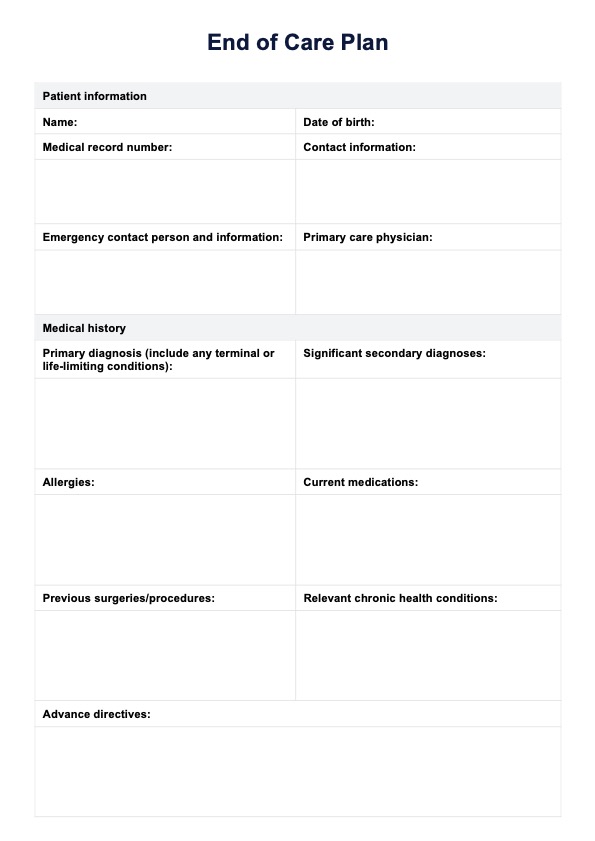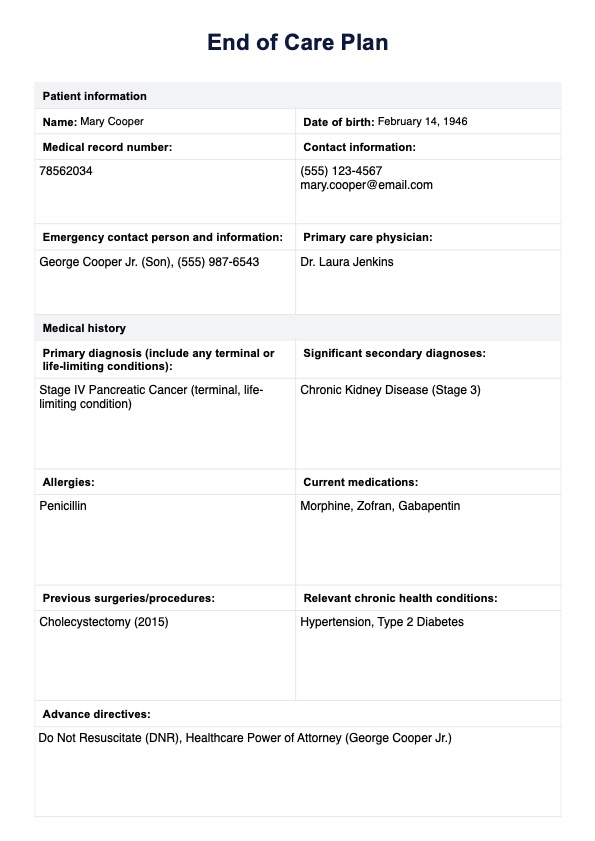End Of Life Care Plan
An end-of-life care plan is an important step towards dignified death and effective palliative care. Learn what to include and more in this informative guide!


What does end-of-life mean?
End-of-life refers to the stage in a person's life when they are approaching death, often due to a life-limiting illness or advanced age. It is a critical period marked by the need for specialized care to ensure the comfort and dignity of the dying person. Health care providers usually provide this care, often in the form of hospice care, which focuses on pain management and symptom relief rather than curative treatments.
End-of-life care involves a collaborative approach between the patient's care team, the individual, and their family members to make decisions that honor the patient’s wishes and improve the quality of their remaining time. Healthcare providers play a vital role in meeting the patient’s physical, emotional, and spiritual needs.
This stage of a patient's life also emphasizes managing discomfort, providing psychological support, and guiding families through the process. Effective pain management is crucial for the patient to experience comfort and peace during this time.
End Of Life Care Plan Template
End Of Life Care Plan Example
What is an end-of-life care plan?
An end-of-life care plan is a comprehensive document that outlines the preferences and needs of a dying patient regarding their healthcare treatment during the final stages of life. It is developed through advance care planning and involves discussions between the individual, their healthcare providers, and family members to ensure that the patient's wishes for medical care are respected. This plan typically includes health care directives, which guide the health care team on how to proceed with treatments based on the patient’s condition and personal values.
An example of an end-of-life care plan may cover areas such as preferences for palliative care, decisions about resuscitation, and other critical end-of-life decisions. It is especially important for those with chronic health conditions or a serious illness, as it ensures that their care focuses on enhancing their quality of life.
Healthcare professionals are crucial in implementing this plan, ensuring the patient's comfort and dignity. By having a well-prepared End-of-Life Care Plan, the individual and their healthcare team can confidently and clearly navigate the complex end-of-life care process.
How does it work?
Carepatron’s End-of-Life Care Plan Template provides healthcare professionals with a structured, easy-to-use tool to support dying patients and their families. Following the steps below, you can ensure the patient’s care is tailored to their needs while aligning with their preferences and end-of-life decisions.
Access the care plan template
Healthcare providers can find the End-of-Life Care Plan Template within this guide. This template offers a comprehensive framework to guide medical professionals through the planning process, ensuring a patient-centered approach to end-of-life care. Simply download or open the template to begin.
Input necessary patient information
Start by entering essential details about the patient, including medical history, current chronic health conditions, and specific healthcare treatment preferences. Ensure that the patient’s serious illness and any previously discussed health care directives are accurately documented to provide clarity for the entire health care team.
Customize care plan according to patient's needs
Every patient’s situation is unique, and their care plan should reflect their personal needs and quality of life goals. Customize the plan based on the patient’s condition, preferences for palliative care, and any special considerations regarding pain management, medical interventions, or other end-of-life services.
Provide patient and family education
It’s important to educate the patient and their family members about the care plan, explaining the available options and what to expect during the end-of-life process. This helps ensure that everyone understands the purpose of the plan and the importance of healthcare treatment decisions.
Discuss next steps
Once the plan is established, collaborate with the patient, their family, and the healthcare team to outline the next steps. This may include ongoing monitoring, adjustments to care, or preparation for future end-of-life phases. Regular communication is key to delivering compassionate and effective care.
When would you use this template?
The End-of-Life Care Plan Template is used when a patient approaches the end of life and requires comprehensive support to ensure their comfort and dignity. Medical professionals use this template in settings such as hospitals, nursing homes, or during hospice care to help guide advance care planning and align treatment with the dying person’s preferences.
It is particularly helpful when a patient needs palliative care to manage pain and improve their overall quality of life during their remaining time. This template ensures that the patient's wishes are honored and respected, especially regarding healthcare decisions and the type of nursing care they wish to receive.
For individuals in the final days or next few hours of life, the template serves as a clear guide for the interdisciplinary team to follow, ensuring seamless care coordination and addressing the patient's evolving needs.
Benefits of an end-of-life care plan
An end-of-life care plan offers numerous benefits for patients and their loved ones during the final stages of life. It provides clarity and ensures that the patient’s healthcare choices are respected while offering essential support during this difficult period. Below are the key benefits.
Respecting the person’s wishes
An end-of-life care plan ensures that a person’s preferences are documented and respected as they approach the end of their life. This includes decisions around medical treatments, pain management, and where they want to receive care, helping healthcare providers understand what should happen during the patient’s final months.
Eases decision-making for loved ones
The plan helps family and friends by outlining clear health care choices in advance, reducing the emotional burden of making difficult decisions. With an advance directive in place, loved ones can feel confident that their decisions align with the patient's wishes.
Provides medical clarity and coordination
The plan ensures that hospice staff, social workers, and other healthcare providers are fully involved in delivering coordinated care tailored to the patient’s medical condition. It helps manage symptoms and ensures that those experiencing pain are supported with proper pain relief strategies.
Supports emotional and social needs
By including elements such as social support and funeral arrangements, the plan assists patients and their loved ones in preparing emotionally and socially for the person’s end. It allows for meaningful moments with family and friends while respecting the patient’s dignity.
Reduces stress for all involved
Knowing that there is a plan in place for what will happen near the end of their life offers peace of mind to both patients and their families. It allows everyone to focus on the time they have left rather than being overwhelmed by decision-making or logistics.
Commonly asked questions
An end-of-life care plan is important because it ensures patients' wishes regarding medical treatment and personal care are clearly documented and respected. This plan enhances the quality of care and provides comfort and peace of mind for both the patient and their loved ones during a challenging time.
Healthcare professionals use end-of-life care plans to guide treatment decisions and care delivery based on the patient’s preferences. It is a communication tool among the health care team, ensuring everyone understands the patient’s desires and coordinates their efforts accordingly.
The four stages of end-of-life care typically include the assessment stage, where patient needs are evaluated; the planning stage, involving the development of the care plan; the implementation stage, where care is provided according to the plan; and the evaluation stage, where the effectiveness of the care plan is reviewed and adjusted as necessary.














































































































